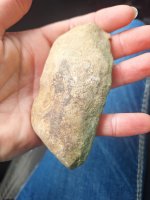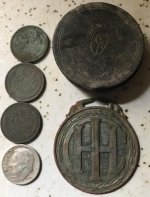NOLA_Ken
Gold Member
- Jan 4, 2011
- 5,214
- 4,178
- Detector(s) used
- several, mostly Garrett
- Primary Interest:
- All Treasure Hunting
As a young radio technician for the New Orleans Police Department in the 1950s, Bob Falcon was told by a friend that he ought to see what was happening on the bridge over Chef Menteur Pass.
So Falcon and other technicians took a detour while working on a radio tower in the area and watched as NOPD officers and trustys shoveled guns from pickups through the drawbridge and into the water below.
"It was an interesting thing to watch, no big deal about it," Falcon said. "They were getting overloaded in the property room and they had to get rid of this stuff. They couldn't sell it and it was the only way to dispose of it."
Falcon and others say that a large cache of guns recently found in the waterway by a diving crew installing electrical lines under the bridge was likely some of thousands of weapons sent to a watery grave by NOPD decades ago.
Officials with the department and with the St. Tammany Parish Sheriff's Office confirmed this week that their agencies historically used local waterways to dispose of weapons collected in the course of investigations. But the two agencies said they did not dump guns into Chef Pass, in eastern New Orleans.
Bob Young, an NOPD spokesman who used to work in the department's property division, was surprised Friday when told that Falcon had watched New Orleans officers disposing of guns in the pass. Young had said previously that he only knew of the department dumping guns in the Mississippi River. Neither police agency dumps guns into waterways today.
Falcon, who retired from the NOPD as a captain and head of the electronics division in 1978, said trustys, a group then made up mainly of vagrants, must have shoveled hundreds of guns into the water as he and his colleagues watched.
"I was into hunting at the time and that was mainly the reason we went down there, a few of us in the department in support services," Falcon said. "We kind of drooled as we watched it go over."
The guns, however, were hardly in pristine condition when they were tossed into the water, Falcon said. Department policies required that weapons first be smashed with a maul to make sure they could not be reused, he said.
Chuck Wright, on the other hand, said he happened upon police officers getting rid of weapons at the site.
Wright said he was on his way to work as a deckhand on a fishing boat one morning in the mid-1970s when two unmarked police cars, with dashboard lights flashing, stopped traffic on the Chef Pass bridge.
Officers got out of the cars and began unloading their vehicles, which were so heavy with guns that their trunks sagged, Wright said. The weapons went over the side, missing a fishing boat near the pylons, he said.
Wright said he saw the same procedure repeated some time later but wasn't sure what agency was dumping the guns on either occasion.
"It's the perfect spot to do it, because who's going to be diving down there anyway?" Wright said. "You can dive there, I guess, but it's dangerous. That current just rolls through there."
One gun in particular stood out: a gold-plated 30-30 rifle that, like the others, was sent to the depths.
"It was such a pretty rifle, such a shame to have them throw them over the bridge," he said.
Slidell resident Bonnie Vanney, who has written books about the waterways in eastern New Orleans, said the area was historically a common place for NOPD to dump all kinds of confiscated materials, including slot machines.
"The Police Department would not let anyone know when they where coming but the locals like myself always (knew) because they blocked the street and told us the day before so we wouldn't run off the bridge," Vanney wrote in an e-mail.
So Falcon and other technicians took a detour while working on a radio tower in the area and watched as NOPD officers and trustys shoveled guns from pickups through the drawbridge and into the water below.
"It was an interesting thing to watch, no big deal about it," Falcon said. "They were getting overloaded in the property room and they had to get rid of this stuff. They couldn't sell it and it was the only way to dispose of it."
Falcon and others say that a large cache of guns recently found in the waterway by a diving crew installing electrical lines under the bridge was likely some of thousands of weapons sent to a watery grave by NOPD decades ago.
Officials with the department and with the St. Tammany Parish Sheriff's Office confirmed this week that their agencies historically used local waterways to dispose of weapons collected in the course of investigations. But the two agencies said they did not dump guns into Chef Pass, in eastern New Orleans.
Bob Young, an NOPD spokesman who used to work in the department's property division, was surprised Friday when told that Falcon had watched New Orleans officers disposing of guns in the pass. Young had said previously that he only knew of the department dumping guns in the Mississippi River. Neither police agency dumps guns into waterways today.
Falcon, who retired from the NOPD as a captain and head of the electronics division in 1978, said trustys, a group then made up mainly of vagrants, must have shoveled hundreds of guns into the water as he and his colleagues watched.
"I was into hunting at the time and that was mainly the reason we went down there, a few of us in the department in support services," Falcon said. "We kind of drooled as we watched it go over."
The guns, however, were hardly in pristine condition when they were tossed into the water, Falcon said. Department policies required that weapons first be smashed with a maul to make sure they could not be reused, he said.
Chuck Wright, on the other hand, said he happened upon police officers getting rid of weapons at the site.
Wright said he was on his way to work as a deckhand on a fishing boat one morning in the mid-1970s when two unmarked police cars, with dashboard lights flashing, stopped traffic on the Chef Pass bridge.
Officers got out of the cars and began unloading their vehicles, which were so heavy with guns that their trunks sagged, Wright said. The weapons went over the side, missing a fishing boat near the pylons, he said.
Wright said he saw the same procedure repeated some time later but wasn't sure what agency was dumping the guns on either occasion.
"It's the perfect spot to do it, because who's going to be diving down there anyway?" Wright said. "You can dive there, I guess, but it's dangerous. That current just rolls through there."
One gun in particular stood out: a gold-plated 30-30 rifle that, like the others, was sent to the depths.
"It was such a pretty rifle, such a shame to have them throw them over the bridge," he said.
Slidell resident Bonnie Vanney, who has written books about the waterways in eastern New Orleans, said the area was historically a common place for NOPD to dump all kinds of confiscated materials, including slot machines.
"The Police Department would not let anyone know when they where coming but the locals like myself always (knew) because they blocked the street and told us the day before so we wouldn't run off the bridge," Vanney wrote in an e-mail.






